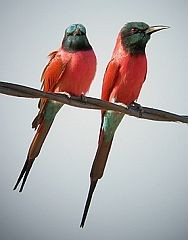The Gambia & Senegal - Trip Report - Nov 09
John Muddeman
28/12/2009 13:21:27
The first Travelling Naturalist trip to Senegambia for a couple of years was superb!
Posted in: Butterflies and Moths, Dragonflies and Damselflies, Amphibians, Reptiles, Birds, Mammals | Non-Iberian
 Northern Carmine Bee-eaters
Northern Carmine Bee-eaters
Merops bullocki© John MuddemanThe Gambia and adjacent Senegal were again visited during two weeks in November, shortly after the start of the dry season and at a time with an abundance of birds, including the remaining wet season breeders, plus a few European migrants amongst the often outrageously coloured local species.
The full trip report can be found on The Travelling Naturalist website, but with nearly 300 bird species recorded, plus a host of other species, incuding three different monkeys, plenty of butterflies and plenty of colourful dragonflies, it's no surprise that this is a superb introduction to W African wildlife. Also, given the constant warm welcome from the incredibly friendly Gambian people, this must surely rank as one of the best and most colourful tours we run!
The higlights are simply too many to note, but did include some really key moments. For me, the pirogue boat trip into the Keur Saloum Delta on our first evening there was simply stunning. Indeed, one of the first birds we saw was the very elusive White-crested Tiger Heron, feeding out on the water's edge, before finally walking off into the depths of the mangroves as we watched in amazement. With no less than eight Goliath Herons, Palm-nut Vulture and African  Makasutu pirogues + mangrove© John MuddemanFish Eagle, this was good, but we were also rewarded with lovely views of a pair of stunningly coloured Saddle-billed Storks, a true rarity in Senegal (and The Gambia). Rounding off until almost dark watching thousands of Cattle Egrets, hundreds of Western Reef Egrets and dozens of Pied Kingfishers coming to roost, was also simply stunning.
Makasutu pirogues + mangrove© John MuddemanFish Eagle, this was good, but we were also rewarded with lovely views of a pair of stunningly coloured Saddle-billed Storks, a true rarity in Senegal (and The Gambia). Rounding off until almost dark watching thousands of Cattle Egrets, hundreds of Western Reef Egrets and dozens of Pied Kingfishers coming to roost, was also simply stunning.
Travelling up-river is exciting both for the changes in wildlife as well as really seeing the Gambian way of life, though a range of bee-eaters on one day was really special, from a beautiful pair of Northern Carmine Bee-eaters to the large breeding colony of outrageously coloured Red-throated Bee-eaters!
Read more blog posts